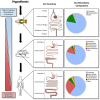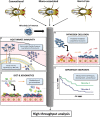Drosophila melanogaster as a High-Throughput Model for Host-Microbiota Interactions
- PMID: 28503170
- PMCID: PMC5408076
- DOI: 10.3389/fmicb.2017.00751
Drosophila melanogaster as a High-Throughput Model for Host-Microbiota Interactions
Abstract
Microbiota research often assumes that differences in abundance and identity of microorganisms have unique influences on host physiology. To test this concept mechanistically, germ-free mice are colonized with microbial communities to assess causation. Due to the cost, infrastructure challenges, and time-consuming nature of germ-free mouse models, an alternative approach is needed to investigate host-microbial interactions. Drosophila melanogaster (fruit flies) can be used as a high throughput in vivo screening model of host-microbiome interactions as they are affordable, convenient, and replicable. D. melanogaster were essential in discovering components of the innate immune response to pathogens. However, axenic D. melanogaster can easily be generated for microbiome studies without the need for ethical considerations. The simplified microbiota structure enables researchers to evaluate permutations of how each microbial species within the microbiota contribute to host phenotypes of interest. This enables the possibility of thorough strain-level analysis of host and microbial properties relevant to physiological outcomes. Moreover, a wide range of mutant D. melanogaster strains can be affordably obtained from public stock centers. Given this, D. melanogaster can be used to identify candidate mechanisms of host-microbe symbioses relevant to pathogen exclusion, innate immunity modulation, diet, xenobiotics, and probiotic/prebiotic properties in a high throughput manner. This perspective comments on the most promising areas of microbiota research that could immediately benefit from using the D. melanogaster model.
Keywords: Drosophila melanogaster; animal model; fruit fly; microbiome; microbiota; prebiotic; probiotic; symbiosis.
Figures


Similar articles
-
Bacterial Metabolism and Transport Genes Are Associated with the Preference of Drosophila melanogaster for Dietary Yeast.Appl Environ Microbiol. 2022 Aug 23;88(16):e0072022. doi: 10.1128/aem.00720-22. Epub 2022 Aug 1. Appl Environ Microbiol. 2022. PMID: 35913151 Free PMC article.
-
Interactions between Drosophila and its natural yeast symbionts-Is Saccharomyces cerevisiae a good model for studying the fly-yeast relationship?PeerJ. 2015 Aug 25;3:e1116. doi: 10.7717/peerj.1116. eCollection 2015. PeerJ. 2015. PMID: 26336636 Free PMC article.
-
Genetic Influences of the Microbiota on the Life Span of Drosophila melanogaster.Appl Environ Microbiol. 2020 May 5;86(10):e00305-20. doi: 10.1128/AEM.00305-20. Print 2020 May 5. Appl Environ Microbiol. 2020. PMID: 32144104 Free PMC article.
-
The role of the microbial environment in Drosophila post-embryonic development.Dev Comp Immunol. 2016 Nov;64:39-52. doi: 10.1016/j.dci.2016.01.017. Epub 2016 Jan 28. Dev Comp Immunol. 2016. PMID: 26827889 Review.
-
Thioester-containing Proteins in the Drosophila melanogaster Immune Response against the Pathogen Photorhabdus.Insects. 2020 Jan 28;11(2):85. doi: 10.3390/insects11020085. Insects. 2020. PMID: 32013030 Free PMC article. Review.
Cited by
-
Drosophila melanogaster as an alternative model organism in nutrigenomics.Genes Nutr. 2019 May 6;14:14. doi: 10.1186/s12263-019-0641-y. eCollection 2019. Genes Nutr. 2019. PMID: 31080523 Free PMC article. Review.
-
DrosoPhyla: Resources for Drosophilid Phylogeny and Systematics.Genome Biol Evol. 2021 Aug 3;13(8):evab179. doi: 10.1093/gbe/evab179. Genome Biol Evol. 2021. PMID: 34343293 Free PMC article.
-
Repression of Staphylococcus aureus and Escherichia coli by Lactiplantibacillus plantarum Strain AG10 in Drosophila melanogaster In Vivo Model.Microorganisms. 2023 May 16;11(5):1297. doi: 10.3390/microorganisms11051297. Microorganisms. 2023. PMID: 37317271 Free PMC article.
-
Caenorhabditis elegans, a Host to Investigate the Probiotic Properties of Beneficial Microorganisms.Front Nutr. 2020 Aug 21;7:135. doi: 10.3389/fnut.2020.00135. eCollection 2020. Front Nutr. 2020. PMID: 33425969 Free PMC article. Review.
-
Capillary Electrophoresis Electrospray Ionization Mass Spectrometry Reveals Metabolic Perturbations During Nematode Infection in Drosophila melanogaster.Molecules. 2025 May 1;30(9):2023. doi: 10.3390/molecules30092023. Molecules. 2025. PMID: 40363828 Free PMC article.
References
LinkOut - more resources
Full Text Sources
Other Literature Sources
Molecular Biology Databases

